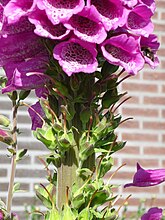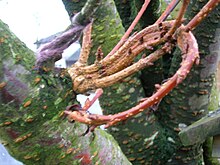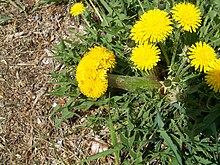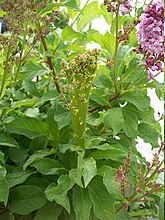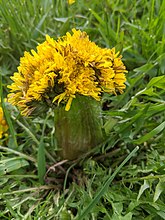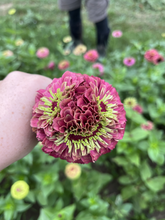Fasciation
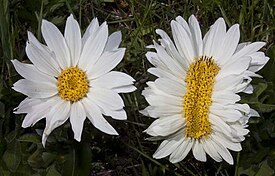

Fasciation (pronounced /ˌfæʃiˈeɪʃən/, from the Latin root meaning "band" or "stripe"), also known as cresting, is a relatively rare condition of abnormal growth in vascular plants in which the apical meristem (growing tip), which normally is concentrated around a single point and produces approximately cylindrical tissue, instead becomes elongated perpendicularly to the direction of growth, thus producing flattened, ribbon-like, crested (or "cristate"), or elaborately contorted tissue.[1] Fasciation may also cause plant parts to increase in weight and volume in some instances.[2] The phenomenon may occur in the stem, root, fruit, or flower head.
Some plants are grown and prized aesthetically for their development of fasciation.[3] Any occurrence of fasciation has several possible causes, including hormonal, genetic, bacterial, fungal, viral and environmental causes.
Cause
[edit]Fasciation can be caused by hormonal imbalances in the meristematic cells of plants, which are cells where growth can occur.[4][5] Fasciation can also be caused by random genetic mutation.[6] Bacterial and viral infections can also cause fasciation.[4] The bacterial phytopathogen Rhodococcus fascians has been demonstrated as one cause of fasciation, such as in sweet pea (Lathyrus odoratus) plants,[7] and in lilies (Lilium longiflorum),[8] but many fasciated plants have tested negative for the bacteria in studies,[9][better source needed] hence bacterial infection is not an exclusive causation.
Additional environmental factors that can cause fasciation include fungi, mite or insect attack and exposure to chemicals.[9] General damage to a plant's growing tip[9] and exposure to cold and frost can also cause fasciation.[4][6] Some plants, such as peas and cockscomb Celosia, may inherit the trait.[9]
Genetic fasciation is not contagious, but infectious fasciation can be spread from infected plants to others from contact with wounds on infected plants, and from water that carries the bacteria to other plants.[10]
Occurrence
[edit]Although fasciation is rare overall, it has been observed in over 100 vascular plant families,[11][better source needed] including members of the genera Acer, Aloe, Acanthosicyos, Cannabis, Celosia, Cycas, Delphinium, Digitalis, Echinacea, Echinopsis, Euphorbia, Forsythia, Glycine max (specifically, soybean plants),[12] Primula, Iochroma, Prunus, Salix, and many genera of the cactus family, Cactaceae.[citation needed] Cresting results in undulating folds instead of the typical "arms" found on mature saguaro cactus.[13]
Some varieties of Celosia are raised especially for their dependably fasciated flower heads, for which they are called "cockscomb".[4] The Japanese fantail willow (Salix sachalinensis 'Sekka') is another plant that is valued for its fasciations.[4][9]
Prevention
[edit]Fasciation that is caused by bacteria can be controlled by not using fasciated plants and disposing of fasciated material.[10] Avoiding injury to plant bases and keeping them dry can reduce the spread of bacteria.[10] Avoidance of grafting fasciated plants and the pruning of fasciated matter can also reduce the spread of bacteria.[10]
Examples
[edit]
- Fasciation
-
An example of fasciation, or "cresting," on a coneflower (Echinacea).
-
Fasciation leading to two fully formed flower heads on a dandelion.
-
Fasciation on Digitalis. Note the larger thickened stem compared to the normal-sized flowering spike on the left.
-
Fasciation on a flowering cherry (Prunus) tree
-
Asparagus (Asparagus officinalis) fasciation. Note the flattened state of the stem. Image published 1893.
-
Common dandelion displaying both regular (upper right) and fasciated (center) flowers.
-
Fasciation on a lilac shrub.
-
Fasciation on a Phacelia campanularia or California bluebell wildflower.
-
Fasciated showy daisy (Erigeron speciosus).
-
Fasciated Crookneck Squash
-
Fasciation seen on common dandelion
-
Regular (left) and fasciated (right) geranium flowers
-
Fasciation in the inflorescence of a cultivated Odontonema tubaeforme plant.
-
Fasciation exhibited on Sedum sexangulare.
-
Fasciation on a zinnia that resembles a smiley face
See also
[edit]References
[edit]- ^ White, Orland E. (1948). "Fasciation". The Botanical Review. 14 (6): 319–358. doi:10.1007/BF02861723.
- ^ Albertsen, Marc C.; Curry, Therese M.; Palmer, Reid G.; Lamotte, Clifford E. (1983). "Genetics and Comparative Growth Morphology of Fasciation in Soybeans (Glycine max [L.] Merr.)". Botanical Gazette. 144 (2): 263–275. doi:10.1086/337372. JSTOR 2474652. S2CID 84260097.
- ^ Morris, Scott. "Fasciation in Flowers – What You Need To Know". Gardentoolbox. Archived from the original on 10 January 2014. Retrieved 10 January 2014.
- ^ a b c d e Lerner, B. Rosie (September 2007). "Fascinating Fasciation". Purdue University Extension. Archived from the original on December 15, 2012. Retrieved July 3, 2012.
- ^ Galun, Esra (2007). Plant Patterning: Structural and Molecular Genetic Aspects. World Scientific Publishing Company. p. 333. ISBN 9789812704085
- ^ a b "Fasciation in Vegetables and Fruits". University of Delaware Cooperative Extension. May 27, 2011. Archived from the original on February 7, 2015. Retrieved July 6, 2012.
- ^ Tilford, P.E. (1936). "Fasciation of Sweet Peas caused by Phytomonas fascians n.sp". Journal of Agricultural Research. 53 (5): 383–394. Retrieved July 7, 2012.
- ^ Lim, Y.-J.; Kong, H. G.; Lee, Y. H.; Kim, H. R.; Park, D. H. (April 2021). "First Report of Rhodococcus fascians Causing Fasciation of Lilies ( Lilium longiflorum ) in South Korea". Plant Disease. 105 (4): 1190. doi:10.1094/PDIS-10-20-2288-PDN. ISSN 0191-2917.
- ^ a b c d e Swift, Curtis E. (April 12, 1999). "Fasciation: Fascinating distortions of the plant world". Colorado State University Extension. Archived from the original on June 30, 2012. Retrieved July 3, 2012.
- ^ a b c d "Managing Pests in Gardens: Floriculture: Diseases: Fasciation". Statewide Integrated Pest Management Program, Agriculture and Natural Resources, University of California. October 13, 2008. Archived from the original on September 15, 2022.
- ^ Tang, Yuhong; Knap, Halina T. (1998). "Fasciation Mutation Enhances Meristematic Activity and Alters Pattern Formation in Soybean". International Journal of Plant Sciences. 159 (2): 249–260. doi:10.1086/297546. ISSN 1058-5893. JSTOR 2475089. S2CID 83559228.
- ^ Yamamoto, Etsuo; et al. (April 25, 2000). "Molecular characterization of two soybean homologs of Arabidopsis thaliana CLAVATA1 from the wild type and fasciation mutant". Biochimica et Biophysica Acta (BBA) - Gene Structure and Expression. 1491 (1–3): 333–340. doi:10.1016/S0167-4781(00)00061-0. PMID 10760600.
- ^ "Campus Arboretum". University of Arizona. 2008-08-20. Archived from the original on 2010-01-06. Retrieved 2010-01-14.
Further reading
[edit]- White, Orland E. (1945). "The Biology of Fasciation". Journal of Heredity. 36: 11–22. doi:10.1093/oxfordjournals.jhered.a105409.
- Crespi, M.; Messens, E.; Caplan, A.B.; Van Montagu, M.; Desomer, J. (1992). "Fasciation induction by the phytopathogen Rhodococcus fascians depends upon a linear plasmid encoding a cytokinin synthase gene". The EMBO Journal. 11 (3): 795–804. doi:10.1002/j.1460-2075.1992.tb05116.x. PMC 556518. PMID 1547783.
- Nilsson, O.; Moritz, T.; Sundberg, B.; Sandberg, G.; Olsson, O. (1996). "Expression of the Agrobacterium rhizogenes rolC Gene in a Deciduous Forest Tree Alters Growth and Development and Leads to Stem Fasciation". Plant Physiology. 112 (2): 493–502. doi:10.1104/pp.112.2.493. PMC 157972. PMID 12226405.
- Crespi, M.; Vereecke, D.; Temmerman, W.; Van Montagu, M.; Desomer, J. (1994). "The fas operon of Rhodococcus fascians encodes new genes required for efficient fasciation of host plants". Journal of Bacteriology. 176 (9): 2492–2501. doi:10.1128/jb.176.9.2492-2501.1994. hdl:1854/LU-322183. PMC 205384. PMID 8169198.
External links
[edit]- "Definition of "Fasciation"". Merriam-Webster Dictionary. Retrieved July 6, 2012.



